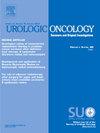TAR-200的开发:一种新的靶向释放系统,旨在为膀胱癌患者提供持续的吉西他滨递送。
IF 2.4
3区 医学
Q3 ONCOLOGY
Urologic Oncology-seminars and Original Investigations
Pub Date : 2025-05-01
DOI:10.1016/j.urolonc.2024.12.264
引用次数: 0
摘要
复发性高风险非肌浸润性膀胱癌(HR NMIBC)和肌浸润性膀胱癌(MIBC)的治疗选择有限,因此需要临床有效、可及且耐受性更好的替代方案。在这篇综述中,我们研究了TAR-200的临床开发计划,这是一种新型靶向释放系统,旨在提供持续的吉西他滨膀胱内递送,以满足NMIBC患者和MIBC患者的需求。我们描述了TAR-200的概念和设计,以及这种吉西他滨膀胱内系统在SunRISe研究组合中的临床发展。这包括3项评估TAR-200安全性和初始肿瘤活性的I期研究和5项II/III期研究,评估TAR-200作为HR NMIBC (bacillus calmette - gusamrin naive[乳头状和原位癌]和MIBC(新辅助和不符合或拒绝根治性膀胱切除术的患者)患者治疗选择的有效性和安全性,无论是否使用全身西曲单抗。药代动力学证明经TAR-200膀胱内递送吉西他滨的时间较长,且无血浆水平检测。I期研究表明,TAR-200耐受性良好,对中危NMIBC和MIBC具有初步的抗肿瘤活性。来自IIb期SunRISe-1研究的初步数据表明,TAR-200单药治疗对卡尔梅特-谷氨酰胺无反应的高风险NMIBC患者是安全有效的。TAR-200是膀胱癌局部治疗的一种创新方法。本文章由计算机程序翻译,如有差异,请以英文原文为准。
Development of TAR-200: A novel targeted releasing system designed to provide sustained delivery of gemcitabine for patients with bladder cancer
Treatment options for recurrent high-risk non–muscle-invasive bladder cancer (HR NMIBC) and muscle-invasive bladder cancer (MIBC) are limited, highlighting a need for clinically effective, accessible, and better-tolerated alternatives. In this review we examine the clinical development program of TAR-200, a novel targeted releasing system designed to provide sustained intravesical delivery of gemcitabine to address the needs of patients with NMIBC and of those with MIBC. We describe the concept and design of TAR-200 and the clinical development of this gemcitabine intravesical system in the SunRISe portfolio of studies. This includes 3 phase I studies evaluating the safety and initial tumor activity of TAR-200 and 5 phase II/III studies assessing the efficacy and safety of TAR-200, with or without systemic cetrelimab, as a treatment option for patients with HR NMIBC (bacillus Calmette-Guérin naive [papillary and carcinoma in situ] and MIBC (neoadjuvant and patients ineligible for or refusing radical cystectomy). Pharmacokinetics demonstrate intravesical gemcitabine delivery via TAR-200 over a prolonged period without detectable plasma levels. Phase I studies showed that TAR-200 is well tolerated, with preliminary antitumor activity in intermediate-risk NMIBC and MIBC. Preliminary data from the phase IIb SunRISe-1 study demonstrate that TAR-200 monotherapy is safe and effective in patients with bacillus Calmette-Guérin–unresponsive high-risk NMIBC. TAR-200 represents an innovative approach to the local treatment of bladder cancer.
求助全文
通过发布文献求助,成功后即可免费获取论文全文。
去求助
来源期刊
CiteScore
4.80
自引率
3.70%
发文量
297
审稿时长
7.6 weeks
期刊介绍:
Urologic Oncology: Seminars and Original Investigations is the official journal of the Society of Urologic Oncology. The journal publishes practical, timely, and relevant clinical and basic science research articles which address any aspect of urologic oncology. Each issue comprises original research, news and topics, survey articles providing short commentaries on other important articles in the urologic oncology literature, and reviews including an in-depth Seminar examining a specific clinical dilemma. The journal periodically publishes supplement issues devoted to areas of current interest to the urologic oncology community. Articles published are of interest to researchers and the clinicians involved in the practice of urologic oncology including urologists, oncologists, and radiologists.

 求助内容:
求助内容: 应助结果提醒方式:
应助结果提醒方式:


